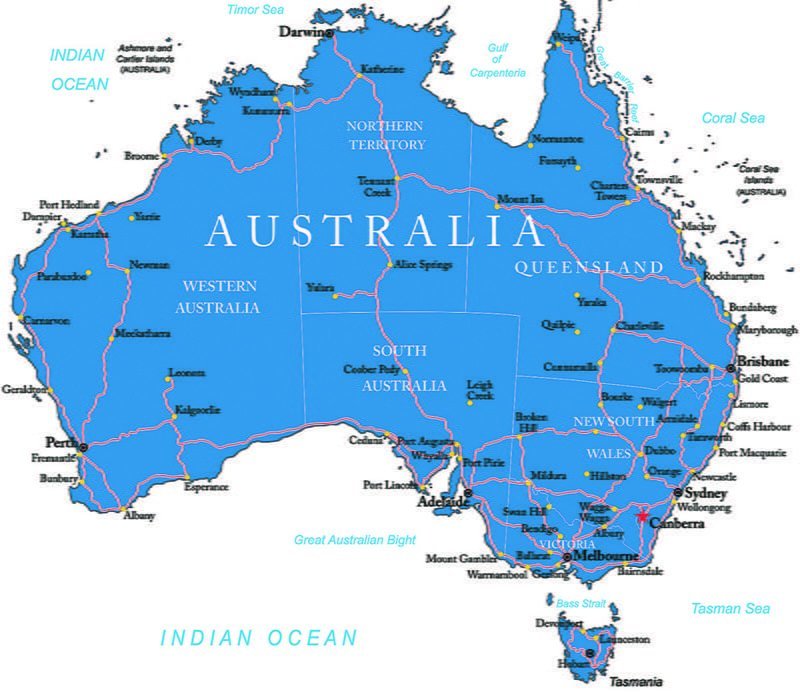The Caravan & Motorhome Book sample chapter
What can go where?
Excepting for much of Western Australia (WA), and the Northern Territory (NT) most roads close to Australia’s coast are bitumen. So is the 14,700 km of Highway 1 that extends all the way round.
Australia’s major roads. Pic: Bogdanserbam/Dreamstime.com
There are two main bitumen roads from Adelaide and Melbourne to Brisbane. One is mostly coastal, the other inland. There is a good road from Brisbane to Weipa (about 300 km short of the tip of Cape York (north Queensland (Qld) but it is a very rugged dirt track thereon.
Another good road runs from Brisbane to Mt Isa and across to Tennant Creek.
On the west coast there are two bitumen roads from Port Hedland to Perth. One follows the coast, the other (via Newman) is inland. It is 400 km shorter but not of great interest from Newman onward.
There is a good bitumen road from from Adelaide to Darwin, via Alice Springs.
In mid 2017, the only bitumen east-west road is between Adelaide and Perth (about 2700 km) across the Nullarbor Plain.
Whilst not shown on the above map, there is an east-west route from Boulia (Qld) via Alice Springs to WA. It is mostly dirt but is being progressively hard surfaced.
The north of WA and the NT apart, most of Australia’s states have often interesting and lightly trafficked back-roads, of which the surfaces are usually well maintained dirt. The east coast and Victoria have many. Some national parks have hard surfaced roads, but most (as also state forests) have dirt roads of varying quality.
What is off-road?
To RV vendors the term ‘off-road’ may be any road lacking a white line down its middle. In reality, ‘off-road’ varies from three lane dirt highways, to where no track may exist at all.
Vendors can mislead, as many have zero such experience. As a result, front-wheel-drive campervans barely able to cross wet grass may be described by vendors as ‘off-road’.
It is also an issue familiarity. An outback bus run is routine for its driver, but an adventure for a first time owner.
The Kimberley’s Gibb River Road is an icon for many four wheel drive owners. Some even proclaim ‘we conquered it’ but my therapist wife travelled its entirety every month it was open (to visit outback Aboriginal communities). The only mildly challenging part is the usually shallow Pentecost River crossing.
The Pentecost River crossing (Gibb River Road) is mostly like this. When not, the track is normally closed to traffic anyway. Pic: Kimberley Kampa.
High ground clearance essential
Outside the wet season, the more rugged caravans, towed by 4WDs, readily travel Australia’s Birdsville, Oodnadatta and Strezlecki tracks. So do many well-made motorhomes and campervans with good ground clearance. If driven with care and in good mechanical condition, occasional such use is unlikely to damage. Doing so regularly though almost certainly will. It may also invalidate warranty.
The main exceptions include the upper part of Cape York (north of Weipa), some tracks off the Gibb River Road, the upper north-west part of the Kimberley, the Canning Stock Route and the Simpson Desert Crossings.
All of the above have deep sandy stretches, severe corrugations, and often sand dunes. They necessitate a really sound 4WD and a truly experienced outback driver.
East-west tracks in north and central WA have a few vehicles a day. The Talavera Track (that takes in part of the Canning Stock Route, has so little it’s rare to meet any at all – for the required three to four days.
The Talavera track (Newman WA to Alice Springs NT) is a rarely-driven route. When we used it, in 2009, we saw no other vehicle for three days. Pic: rvbooks.com.au
Seek current advice before using any of the above. Ideally travel with at least one other 4WD.
Think hard about whether you really wish to travel extensively on dirt roads, or just like the idea. We loved it, but the reality is dirt and discomfort. Only a few of Australia’s most interesting areas can really require the full-on hard-core approach. Virtually all can be amply explored via short professionally tours in suitably rugged vehicles.
Vehicles required for serious off-road travel are covered in a later Chapter.
Corrugation
Corrugation is virtually the natural state of dirt tracks travelled by wheeled vehicles. It is an ongoing series of traffic-formed ridges 700-900 mm apart. The severity of corrugations depends on the nature of the surface, the amount and type of traffic and when the track was last graded.
This track is typical of corrugations Australia-wide. Pic: original source unknown.
Traversing very rough going requires extreme care, but it is long term driving over corrugations that eventually damages all but the rugged vehicles and trailers. In particular, doing so whilst carrying excessive weight typically causes structural and other damage.
Over such going it is essential to have top quality shock absorbers. These need renewing every 30,000 – 50,000 km. Their rubber bushes need to be regularly inspected and replaced as needed. It also assists by reducing tyre pressures (all round) by 25% or so – and keeping speed below 80 km/h (50 mph).
